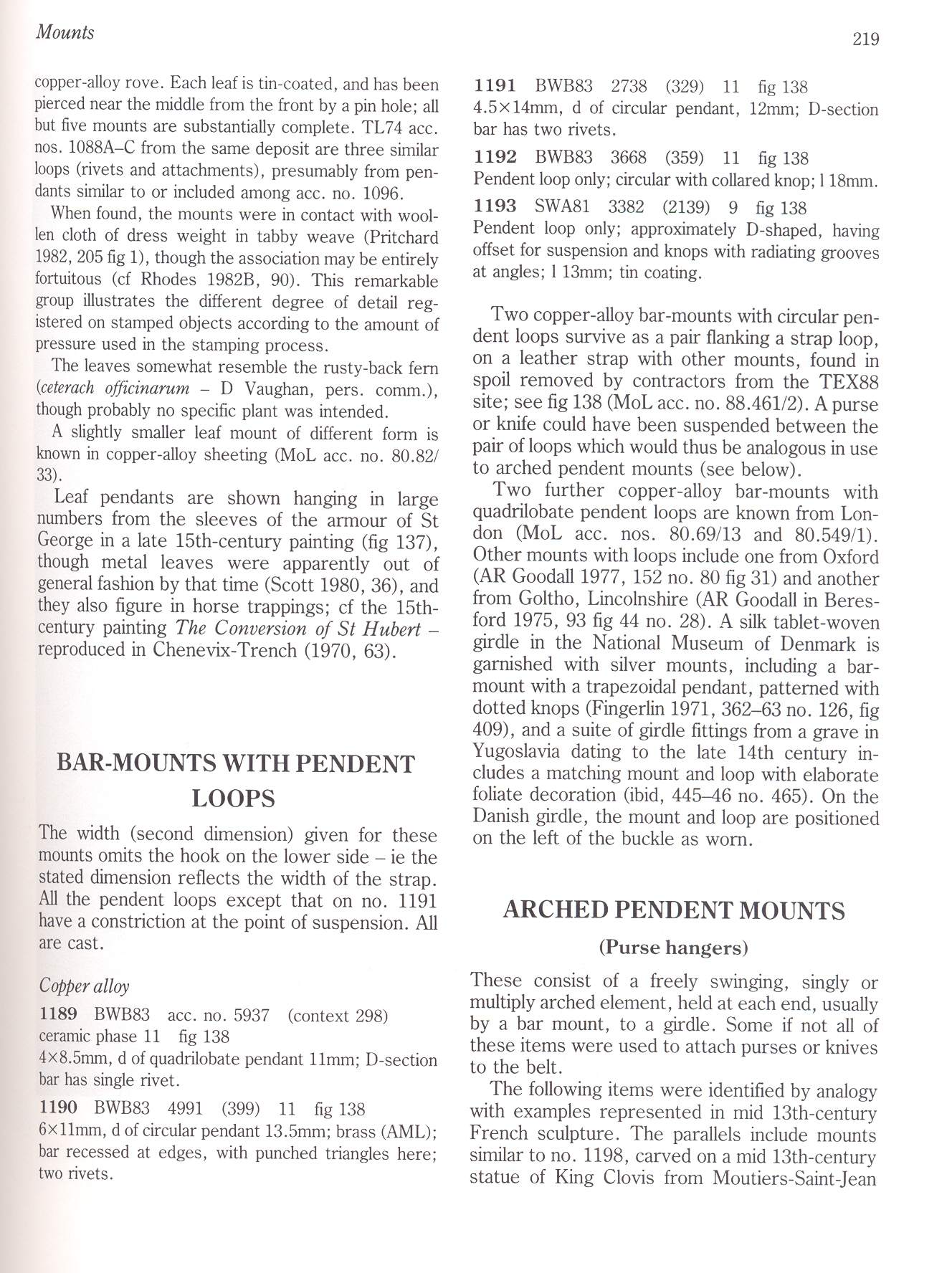248 (50)

219
Mounts
copper-alloy rove. Each leaf is tin-coated, and has been pierced near the middle from the front by a pin hole; all but five mounts are substantially complete. TL74 acc. nos. 1088A-C from the same deposit are three similar loops (rivets and attachments), presumably from pen-dants similar to or included among acc. no. 1096.
When found, the mounts were in contact with wool-len cloth of dress weight in tabby weave (Pritchard 1982, 205 fig 1), though the association may be entirely fortuitous (cf Rhodes 1982B, 90). This remarkable group illustrates the different degree of detail reg-istered on stamped objects according to the amount of pressure used in the stamping process.
The leaves somewhat resemble the rusty-back fem (<ceterach officinarum - D Vaughan, pers. comm.), though probably no specific plant was intended.
A slightly smaller leaf mount of different form is known in copper-alloy sheeting (MoL acc. no. 80.82/ 33).
Leaf pendants are shown hanging in large numbers from the sleeves of the armour of St George in a late 15th-century painting (fig 137), though metal leaves were apparently out of generał fashion by that time (Scott 1980, 36), and they also figurę in horse trappings; cf the 15th-century painting The Conversion of St Hubert -reproduced in Chenevix-Trench (1970, 63).
BAR-MOUNTS WITH PENDENT LOOPS
The width (second dimension) given for these mounts omits the hook on the lower side - ie the stated dimension reflects the width of the strap. All the pendent loops except that on no. 1191 have a constriction at the point of suspension. All are cast.
Copper alloy
1189 BWB83 acc. no. 5937 (context 298) ceramic phase 11 fig 138
4x8.5mm, d of ąuadrilobate pendant llmm; D-section bar has single rivet.
1190 BWB83 4991 (399) 11 fig 138 6xllmm, d of circular pendant 13.5mm; brass (AML); bar recessed at edges, with punched triangles here; two rivets.
1191 BWB83 2738 (329) 11 fig 138
4.5xl4mm, d of circular pendant, 12mm; D-section bar has two rivets.
1192 BWB83 3668 (359) 11 fig 138
Pendent loop only; circular with collared knop; 118mm.
1193 SWA81 3382 (2139) 9 fig 138
Pendent loop only; approximately D-shaped, having offset for suspension and knops with radiating grooves at angles; 1 13mm; tin coating.
Two copper-alloy bar-mounts with circular pendent loops survive as a pair flanking a strap loop, on a leather strap with other mounts, found in spoił removed by contractors from the TEX88 site; see fig 138 (MoL acc. no. 88.461/2). A purse or knife could have been suspended between the pair of loops which would thus be analogous in use to arched pendent mounts (see below).
Two further copper-alloy bar-mounts with ąuadrilobate pendent loops are known from London (MoL acc. nos. 80.69/13 and 80.549/1). Other mounts with loops include one from Oxford (AR Goodall 1977, 152 no. 80 fig 31) and another from Goltho, Lincolnshire (AR Goodall in Beres-ford 1975, 93 fig 44 no. 28). A silk tablet-woven girdle in the National Museum of Denmark is gamished with silver mounts, including a bar-mount with a trapezoidal pendant, pattemed with dotted knops (Fingerlin 1971, 362-63 no. 126, fig 409), and a suitę of girdle fittings from a grave in Yugoslavia dating to the late 14th century in-cludes a matching mount and loop with elaborate foliate decoration (ibid, 445-46 no. 465). On the Danish girdle, the mount and loop are positioned on the left of the buckie as wom.
ARCHED PENDENT MOUNTS
(Purse hangers)
These consist of a freely swinging, singly or multiply arched element, held at each end, usually by a bar mount, to a girdle. Some if not all of these items were used to attach purses or knives to the belt.
The following items were identified by analogy with examples represented in mid 13th-century French sculpture. The parallels include mounts similar to no. 1198, carved on a mid 13th-century statuę of King Clovis from Moutiers-Saint-Jean
Wyszukiwarka
Podobne podstrony:
Picture (6) Each piece is self enclosed, and only attaches to the next piece once all parts are comp
244 (51) 215 Mounts Arrow shaped Copper alloy 1163
284 (41) 256 Dress Accessońes Hooked annular brooch Copper alloy 1338 SWA81 acc. no. 1493 (context
323 (29) 295 Wire headdress frames 195 Silk-covered, copper alloy wire headdress frame with tra
50 (219) WIEŚCICO ROBIĄ GWIAZDY POAKCJA Z TAYLOREM Przystojniak Taylor Lautner jest także bardzo pop
50 (248) 50 Jerzy Bartmiński brze zadomowioną nazwę odmian językowych. Odmiany języka charakteryzuje
w01c A I2th- or ijth-century mace head madę from copper-alloy. Although light in compariso
20 F. LE CORSU E. kersen, The Myth of Egypt and its Hieroglyphs in European Tradition : BiOr 19, 248
389 (12) 362 Dress Accessońes i 1716 r 1717 241 Top and bottom left, cast copper alloy mirror cases;
395 (13) 368 Dress Accessońes 245 Antler composite combs with copper alloy rivets nos. 1719-20 and t
223 (60) 194 Dress AccessońesOCTOFOILS Domed, with holes for separate, single rivets Copper alloy 10
img021 (15) How does each moue? How does each eat? K. i- iLIFE CYCLE Buttenlies and moths are all ad
sql2 2302 Oirecl access lo tables: Each program is responsiOle for maintaining transaction integrity
Name: Number: Datę: 1- Match each picturc to its namc and paint thcm. This is a pink dress. This is
Hughes, Susanna Melinda and Sophia (SB) Sleeping with the other two girls was not easy. Each, in h
więcej podobnych podstron